Analysis of Siemens' Business Strategy and Strategic Transformation
VerifiedAdded on 2022/12/27
|21
|4618
|64
Report
AI Summary
This report analyzes Siemens' business strategy, focusing on the impact of future environmental forces and megatrends such as globalization, digitalization, demographic change, climatic change, and urbanization. It examines the threats and opportunities these forces present to Siemens' various business sectors, including power generation, industrial solutions, and medical services. The report details the context of Siemens' strategic transformation, emphasizing the challenges related to digitalization and the creation of an 'ownership culture,' particularly those faced by Torsten Ende in influencing strategy implementation. It evaluates the steps taken and planned to facilitate the adoption of Siemens' future strategy within its businesses, incorporating a PESTLE analysis to assess the political, economic, social, technological, legal, and environmental factors affecting the company. The analysis further explores the challenges of digitalization, automation, and the staged approach to strategic transformation, including short-term, medium-term, and long-term priorities, as well as the application of the Kaleidoscope model. The report concludes by assessing the company’s readiness for strategic transformations and the expected impact on stakeholders.
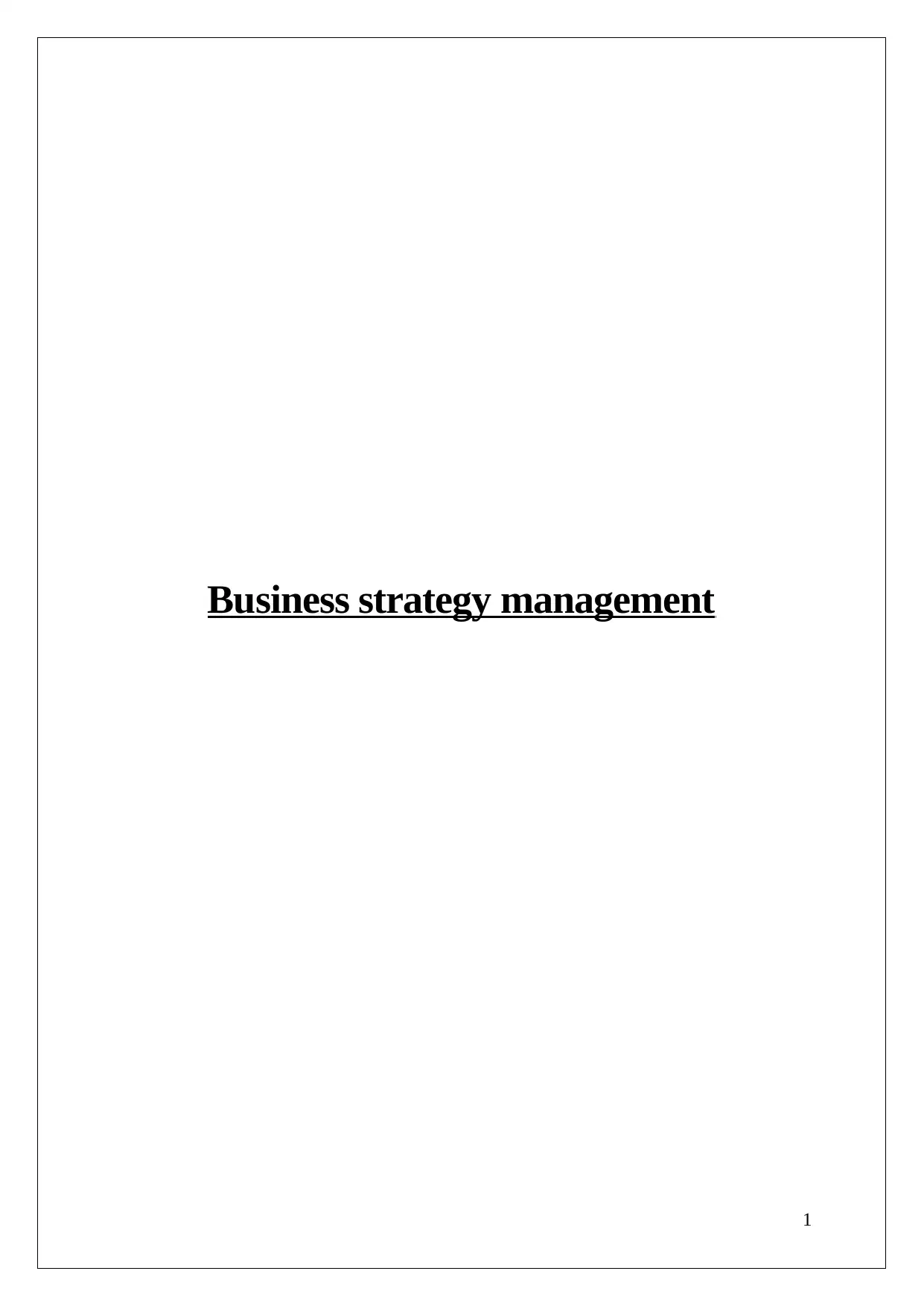
Business strategy management
1
1
Paraphrase This Document
Need a fresh take? Get an instant paraphrase of this document with our AI Paraphraser
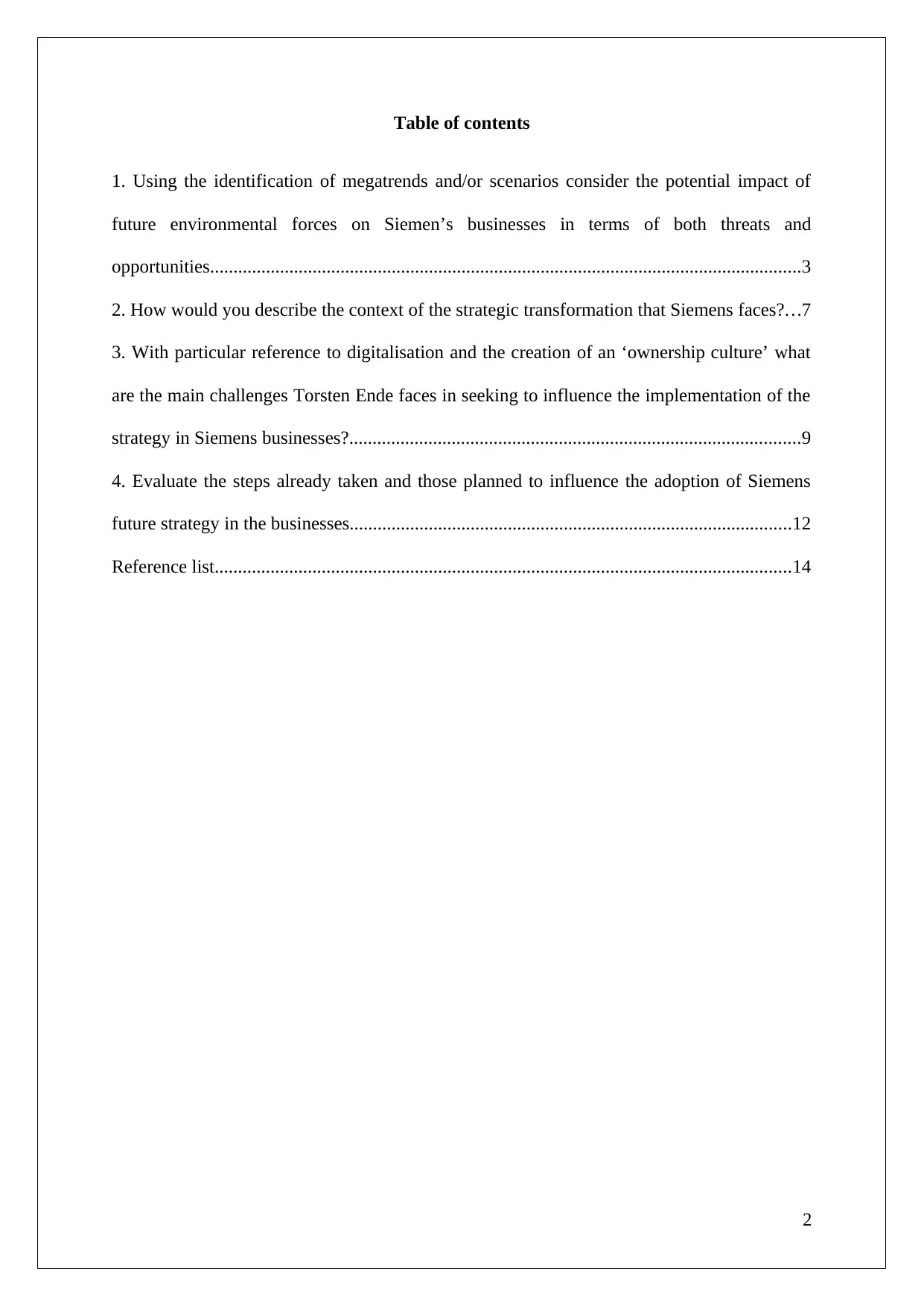
Table of contents
1. Using the identification of megatrends and/or scenarios consider the potential impact of
future environmental forces on Siemen’s businesses in terms of both threats and
opportunities...............................................................................................................................3
2. How would you describe the context of the strategic transformation that Siemens faces?...7
3. With particular reference to digitalisation and the creation of an ‘ownership culture’ what
are the main challenges Torsten Ende faces in seeking to influence the implementation of the
strategy in Siemens businesses?.................................................................................................9
4. Evaluate the steps already taken and those planned to influence the adoption of Siemens
future strategy in the businesses...............................................................................................12
Reference list............................................................................................................................14
2
1. Using the identification of megatrends and/or scenarios consider the potential impact of
future environmental forces on Siemen’s businesses in terms of both threats and
opportunities...............................................................................................................................3
2. How would you describe the context of the strategic transformation that Siemens faces?...7
3. With particular reference to digitalisation and the creation of an ‘ownership culture’ what
are the main challenges Torsten Ende faces in seeking to influence the implementation of the
strategy in Siemens businesses?.................................................................................................9
4. Evaluate the steps already taken and those planned to influence the adoption of Siemens
future strategy in the businesses...............................................................................................12
Reference list............................................................................................................................14
2
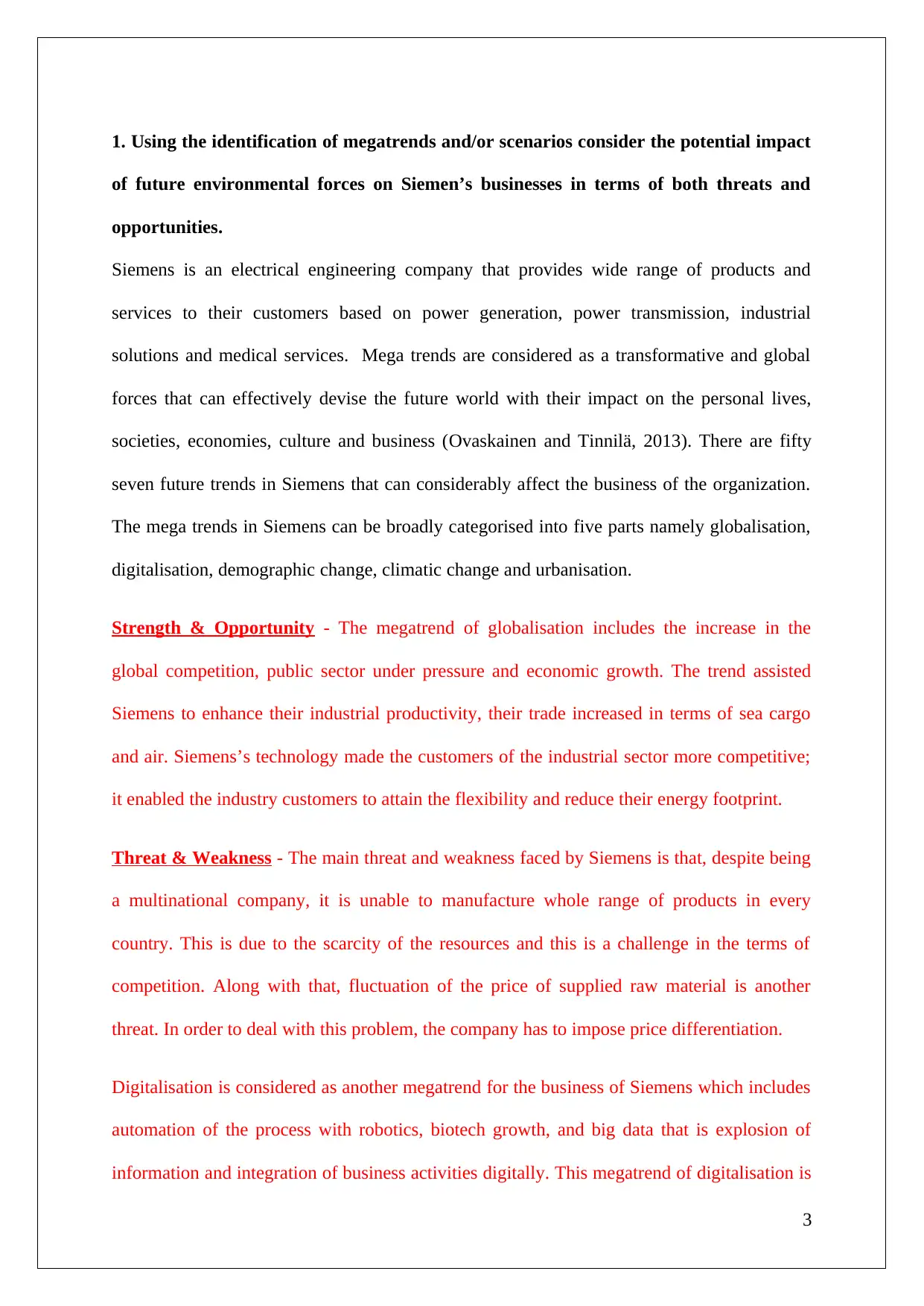
1. Using the identification of megatrends and/or scenarios consider the potential impact
of future environmental forces on Siemen’s businesses in terms of both threats and
opportunities.
Siemens is an electrical engineering company that provides wide range of products and
services to their customers based on power generation, power transmission, industrial
solutions and medical services. Mega trends are considered as a transformative and global
forces that can effectively devise the future world with their impact on the personal lives,
societies, economies, culture and business (Ovaskainen and Tinnilä, 2013). There are fifty
seven future trends in Siemens that can considerably affect the business of the organization.
The mega trends in Siemens can be broadly categorised into five parts namely globalisation,
digitalisation, demographic change, climatic change and urbanisation.
Strength & Opportunity - The megatrend of globalisation includes the increase in the
global competition, public sector under pressure and economic growth. The trend assisted
Siemens to enhance their industrial productivity, their trade increased in terms of sea cargo
and air. Siemens’s technology made the customers of the industrial sector more competitive;
it enabled the industry customers to attain the flexibility and reduce their energy footprint.
Threat & Weakness - The main threat and weakness faced by Siemens is that, despite being
a multinational company, it is unable to manufacture whole range of products in every
country. This is due to the scarcity of the resources and this is a challenge in the terms of
competition. Along with that, fluctuation of the price of supplied raw material is another
threat. In order to deal with this problem, the company has to impose price differentiation.
Digitalisation is considered as another megatrend for the business of Siemens which includes
automation of the process with robotics, biotech growth, and big data that is explosion of
information and integration of business activities digitally. This megatrend of digitalisation is
3
of future environmental forces on Siemen’s businesses in terms of both threats and
opportunities.
Siemens is an electrical engineering company that provides wide range of products and
services to their customers based on power generation, power transmission, industrial
solutions and medical services. Mega trends are considered as a transformative and global
forces that can effectively devise the future world with their impact on the personal lives,
societies, economies, culture and business (Ovaskainen and Tinnilä, 2013). There are fifty
seven future trends in Siemens that can considerably affect the business of the organization.
The mega trends in Siemens can be broadly categorised into five parts namely globalisation,
digitalisation, demographic change, climatic change and urbanisation.
Strength & Opportunity - The megatrend of globalisation includes the increase in the
global competition, public sector under pressure and economic growth. The trend assisted
Siemens to enhance their industrial productivity, their trade increased in terms of sea cargo
and air. Siemens’s technology made the customers of the industrial sector more competitive;
it enabled the industry customers to attain the flexibility and reduce their energy footprint.
Threat & Weakness - The main threat and weakness faced by Siemens is that, despite being
a multinational company, it is unable to manufacture whole range of products in every
country. This is due to the scarcity of the resources and this is a challenge in the terms of
competition. Along with that, fluctuation of the price of supplied raw material is another
threat. In order to deal with this problem, the company has to impose price differentiation.
Digitalisation is considered as another megatrend for the business of Siemens which includes
automation of the process with robotics, biotech growth, and big data that is explosion of
information and integration of business activities digitally. This megatrend of digitalisation is
3
⊘ This is a preview!⊘
Do you want full access?
Subscribe today to unlock all pages.

Trusted by 1+ million students worldwide
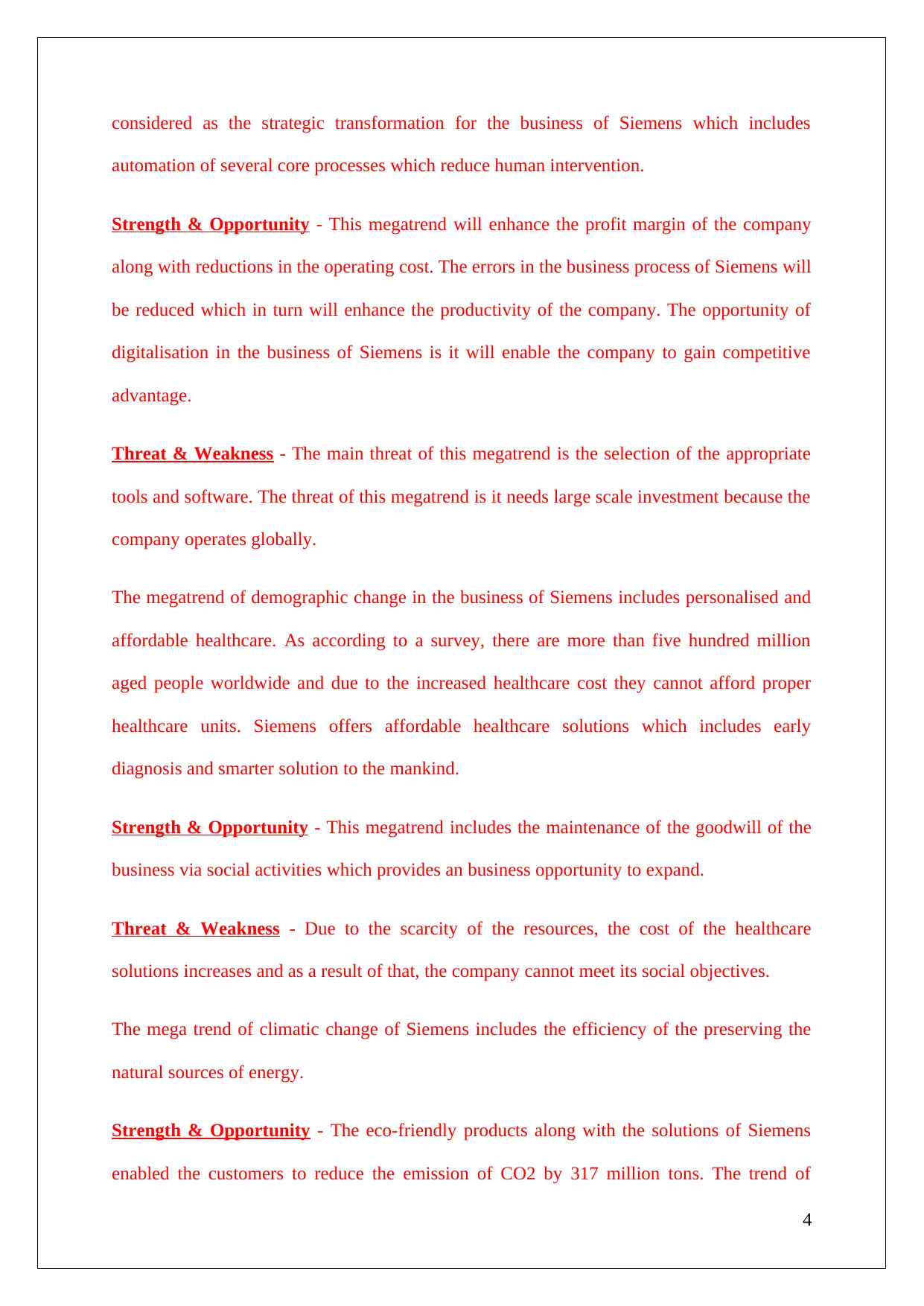
considered as the strategic transformation for the business of Siemens which includes
automation of several core processes which reduce human intervention.
Strength & Opportunity - This megatrend will enhance the profit margin of the company
along with reductions in the operating cost. The errors in the business process of Siemens will
be reduced which in turn will enhance the productivity of the company. The opportunity of
digitalisation in the business of Siemens is it will enable the company to gain competitive
advantage.
Threat & Weakness - The main threat of this megatrend is the selection of the appropriate
tools and software. The threat of this megatrend is it needs large scale investment because the
company operates globally.
The megatrend of demographic change in the business of Siemens includes personalised and
affordable healthcare. As according to a survey, there are more than five hundred million
aged people worldwide and due to the increased healthcare cost they cannot afford proper
healthcare units. Siemens offers affordable healthcare solutions which includes early
diagnosis and smarter solution to the mankind.
Strength & Opportunity - This megatrend includes the maintenance of the goodwill of the
business via social activities which provides an business opportunity to expand.
Threat & Weakness - Due to the scarcity of the resources, the cost of the healthcare
solutions increases and as a result of that, the company cannot meet its social objectives.
The mega trend of climatic change of Siemens includes the efficiency of the preserving the
natural sources of energy.
Strength & Opportunity - The eco-friendly products along with the solutions of Siemens
enabled the customers to reduce the emission of CO2 by 317 million tons. The trend of
4
automation of several core processes which reduce human intervention.
Strength & Opportunity - This megatrend will enhance the profit margin of the company
along with reductions in the operating cost. The errors in the business process of Siemens will
be reduced which in turn will enhance the productivity of the company. The opportunity of
digitalisation in the business of Siemens is it will enable the company to gain competitive
advantage.
Threat & Weakness - The main threat of this megatrend is the selection of the appropriate
tools and software. The threat of this megatrend is it needs large scale investment because the
company operates globally.
The megatrend of demographic change in the business of Siemens includes personalised and
affordable healthcare. As according to a survey, there are more than five hundred million
aged people worldwide and due to the increased healthcare cost they cannot afford proper
healthcare units. Siemens offers affordable healthcare solutions which includes early
diagnosis and smarter solution to the mankind.
Strength & Opportunity - This megatrend includes the maintenance of the goodwill of the
business via social activities which provides an business opportunity to expand.
Threat & Weakness - Due to the scarcity of the resources, the cost of the healthcare
solutions increases and as a result of that, the company cannot meet its social objectives.
The mega trend of climatic change of Siemens includes the efficiency of the preserving the
natural sources of energy.
Strength & Opportunity - The eco-friendly products along with the solutions of Siemens
enabled the customers to reduce the emission of CO2 by 317 million tons. The trend of
4
Paraphrase This Document
Need a fresh take? Get an instant paraphrase of this document with our AI Paraphraser
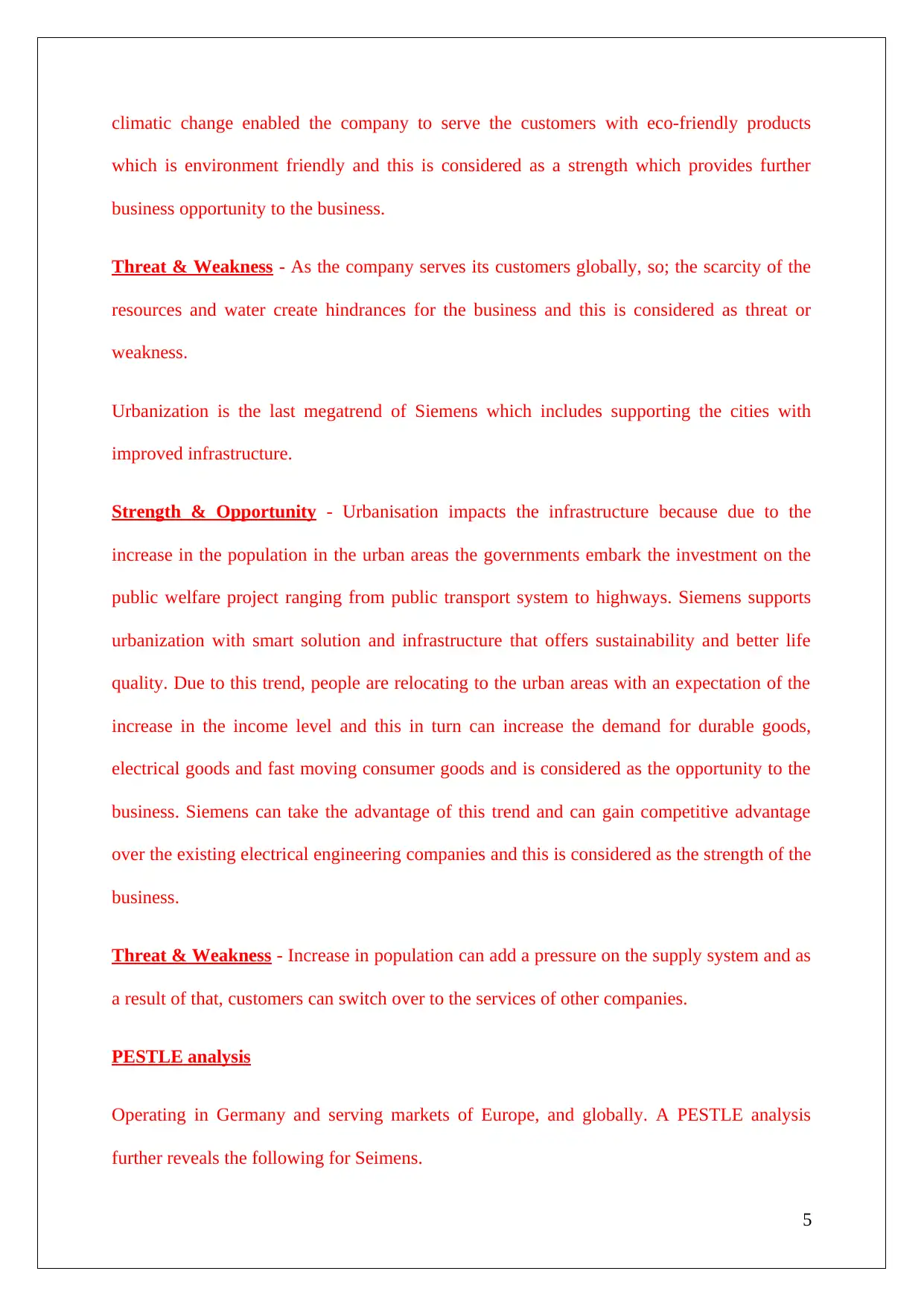
climatic change enabled the company to serve the customers with eco-friendly products
which is environment friendly and this is considered as a strength which provides further
business opportunity to the business.
Threat & Weakness - As the company serves its customers globally, so; the scarcity of the
resources and water create hindrances for the business and this is considered as threat or
weakness.
Urbanization is the last megatrend of Siemens which includes supporting the cities with
improved infrastructure.
Strength & Opportunity - Urbanisation impacts the infrastructure because due to the
increase in the population in the urban areas the governments embark the investment on the
public welfare project ranging from public transport system to highways. Siemens supports
urbanization with smart solution and infrastructure that offers sustainability and better life
quality. Due to this trend, people are relocating to the urban areas with an expectation of the
increase in the income level and this in turn can increase the demand for durable goods,
electrical goods and fast moving consumer goods and is considered as the opportunity to the
business. Siemens can take the advantage of this trend and can gain competitive advantage
over the existing electrical engineering companies and this is considered as the strength of the
business.
Threat & Weakness - Increase in population can add a pressure on the supply system and as
a result of that, customers can switch over to the services of other companies.
PESTLE analysis
Operating in Germany and serving markets of Europe, and globally. A PESTLE analysis
further reveals the following for Seimens.
5
which is environment friendly and this is considered as a strength which provides further
business opportunity to the business.
Threat & Weakness - As the company serves its customers globally, so; the scarcity of the
resources and water create hindrances for the business and this is considered as threat or
weakness.
Urbanization is the last megatrend of Siemens which includes supporting the cities with
improved infrastructure.
Strength & Opportunity - Urbanisation impacts the infrastructure because due to the
increase in the population in the urban areas the governments embark the investment on the
public welfare project ranging from public transport system to highways. Siemens supports
urbanization with smart solution and infrastructure that offers sustainability and better life
quality. Due to this trend, people are relocating to the urban areas with an expectation of the
increase in the income level and this in turn can increase the demand for durable goods,
electrical goods and fast moving consumer goods and is considered as the opportunity to the
business. Siemens can take the advantage of this trend and can gain competitive advantage
over the existing electrical engineering companies and this is considered as the strength of the
business.
Threat & Weakness - Increase in population can add a pressure on the supply system and as
a result of that, customers can switch over to the services of other companies.
PESTLE analysis
Operating in Germany and serving markets of Europe, and globally. A PESTLE analysis
further reveals the following for Seimens.
5
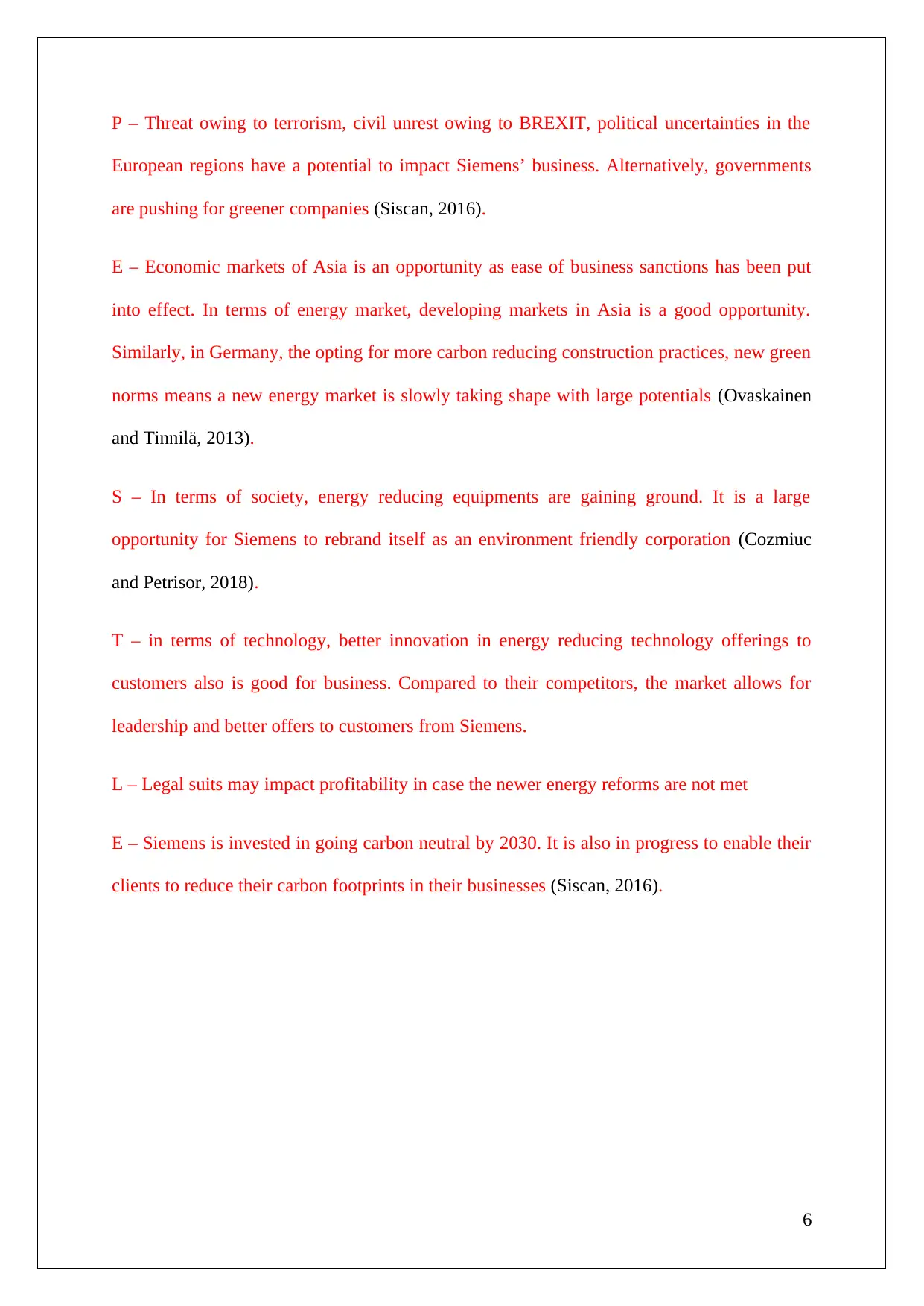
P – Threat owing to terrorism, civil unrest owing to BREXIT, political uncertainties in the
European regions have a potential to impact Siemens’ business. Alternatively, governments
are pushing for greener companies (Siscan, 2016).
E – Economic markets of Asia is an opportunity as ease of business sanctions has been put
into effect. In terms of energy market, developing markets in Asia is a good opportunity.
Similarly, in Germany, the opting for more carbon reducing construction practices, new green
norms means a new energy market is slowly taking shape with large potentials (Ovaskainen
and Tinnilä, 2013).
S – In terms of society, energy reducing equipments are gaining ground. It is a large
opportunity for Siemens to rebrand itself as an environment friendly corporation (Cozmiuc
and Petrisor, 2018).
T – in terms of technology, better innovation in energy reducing technology offerings to
customers also is good for business. Compared to their competitors, the market allows for
leadership and better offers to customers from Siemens.
L – Legal suits may impact profitability in case the newer energy reforms are not met
E – Siemens is invested in going carbon neutral by 2030. It is also in progress to enable their
clients to reduce their carbon footprints in their businesses (Siscan, 2016).
6
European regions have a potential to impact Siemens’ business. Alternatively, governments
are pushing for greener companies (Siscan, 2016).
E – Economic markets of Asia is an opportunity as ease of business sanctions has been put
into effect. In terms of energy market, developing markets in Asia is a good opportunity.
Similarly, in Germany, the opting for more carbon reducing construction practices, new green
norms means a new energy market is slowly taking shape with large potentials (Ovaskainen
and Tinnilä, 2013).
S – In terms of society, energy reducing equipments are gaining ground. It is a large
opportunity for Siemens to rebrand itself as an environment friendly corporation (Cozmiuc
and Petrisor, 2018).
T – in terms of technology, better innovation in energy reducing technology offerings to
customers also is good for business. Compared to their competitors, the market allows for
leadership and better offers to customers from Siemens.
L – Legal suits may impact profitability in case the newer energy reforms are not met
E – Siemens is invested in going carbon neutral by 2030. It is also in progress to enable their
clients to reduce their carbon footprints in their businesses (Siscan, 2016).
6
⊘ This is a preview!⊘
Do you want full access?
Subscribe today to unlock all pages.

Trusted by 1+ million students worldwide
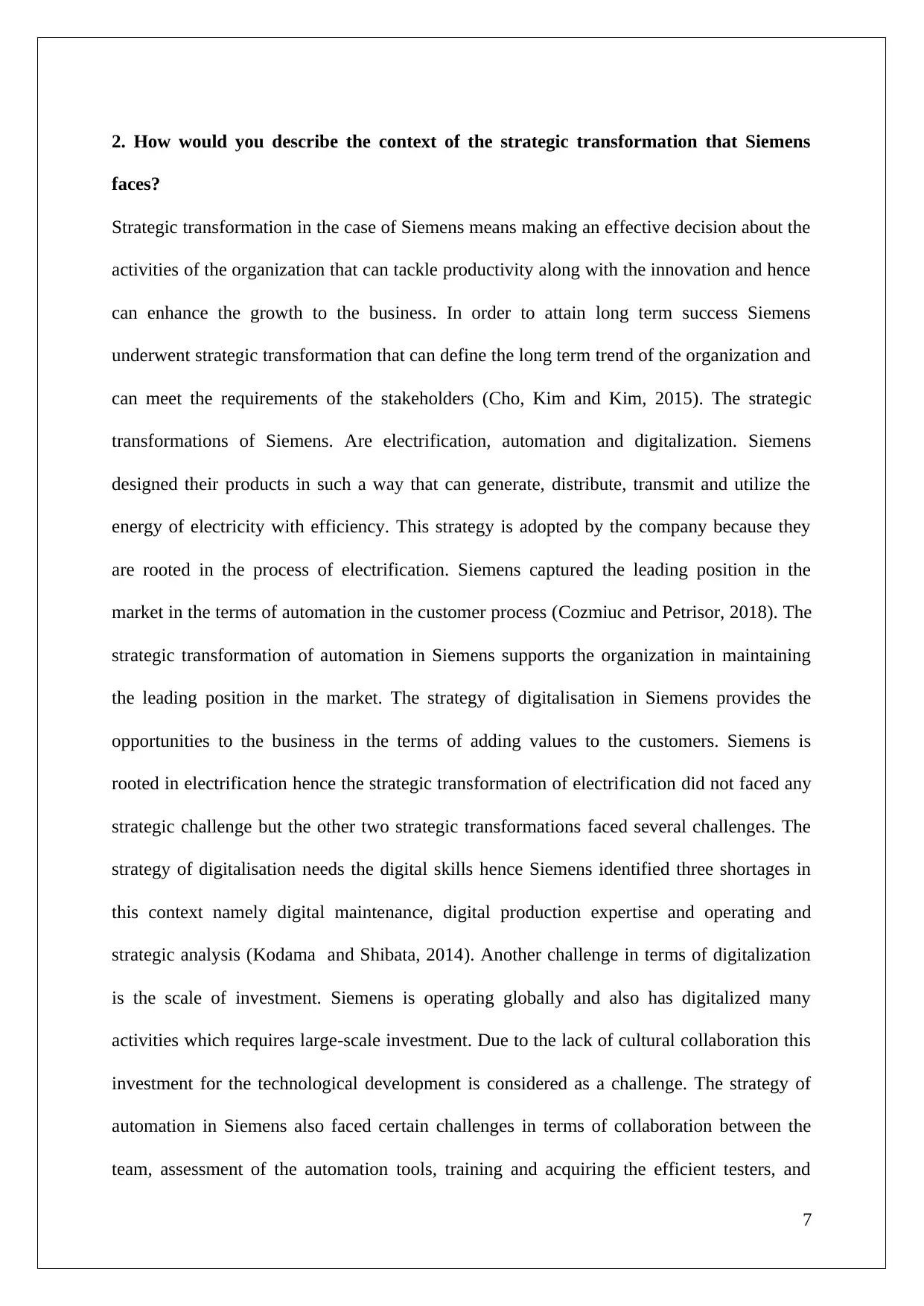
2. How would you describe the context of the strategic transformation that Siemens
faces?
Strategic transformation in the case of Siemens means making an effective decision about the
activities of the organization that can tackle productivity along with the innovation and hence
can enhance the growth to the business. In order to attain long term success Siemens
underwent strategic transformation that can define the long term trend of the organization and
can meet the requirements of the stakeholders (Cho, Kim and Kim, 2015). The strategic
transformations of Siemens. Are electrification, automation and digitalization. Siemens
designed their products in such a way that can generate, distribute, transmit and utilize the
energy of electricity with efficiency. This strategy is adopted by the company because they
are rooted in the process of electrification. Siemens captured the leading position in the
market in the terms of automation in the customer process (Cozmiuc and Petrisor, 2018). The
strategic transformation of automation in Siemens supports the organization in maintaining
the leading position in the market. The strategy of digitalisation in Siemens provides the
opportunities to the business in the terms of adding values to the customers. Siemens is
rooted in electrification hence the strategic transformation of electrification did not faced any
strategic challenge but the other two strategic transformations faced several challenges. The
strategy of digitalisation needs the digital skills hence Siemens identified three shortages in
this context namely digital maintenance, digital production expertise and operating and
strategic analysis (Kodama and Shibata, 2014). Another challenge in terms of digitalization
is the scale of investment. Siemens is operating globally and also has digitalized many
activities which requires large-scale investment. Due to the lack of cultural collaboration this
investment for the technological development is considered as a challenge. The strategy of
automation in Siemens also faced certain challenges in terms of collaboration between the
team, assessment of the automation tools, training and acquiring the efficient testers, and
7
faces?
Strategic transformation in the case of Siemens means making an effective decision about the
activities of the organization that can tackle productivity along with the innovation and hence
can enhance the growth to the business. In order to attain long term success Siemens
underwent strategic transformation that can define the long term trend of the organization and
can meet the requirements of the stakeholders (Cho, Kim and Kim, 2015). The strategic
transformations of Siemens. Are electrification, automation and digitalization. Siemens
designed their products in such a way that can generate, distribute, transmit and utilize the
energy of electricity with efficiency. This strategy is adopted by the company because they
are rooted in the process of electrification. Siemens captured the leading position in the
market in the terms of automation in the customer process (Cozmiuc and Petrisor, 2018). The
strategic transformation of automation in Siemens supports the organization in maintaining
the leading position in the market. The strategy of digitalisation in Siemens provides the
opportunities to the business in the terms of adding values to the customers. Siemens is
rooted in electrification hence the strategic transformation of electrification did not faced any
strategic challenge but the other two strategic transformations faced several challenges. The
strategy of digitalisation needs the digital skills hence Siemens identified three shortages in
this context namely digital maintenance, digital production expertise and operating and
strategic analysis (Kodama and Shibata, 2014). Another challenge in terms of digitalization
is the scale of investment. Siemens is operating globally and also has digitalized many
activities which requires large-scale investment. Due to the lack of cultural collaboration this
investment for the technological development is considered as a challenge. The strategy of
automation in Siemens also faced certain challenges in terms of collaboration between the
team, assessment of the automation tools, training and acquiring the efficient testers, and
7
Paraphrase This Document
Need a fresh take? Get an instant paraphrase of this document with our AI Paraphraser
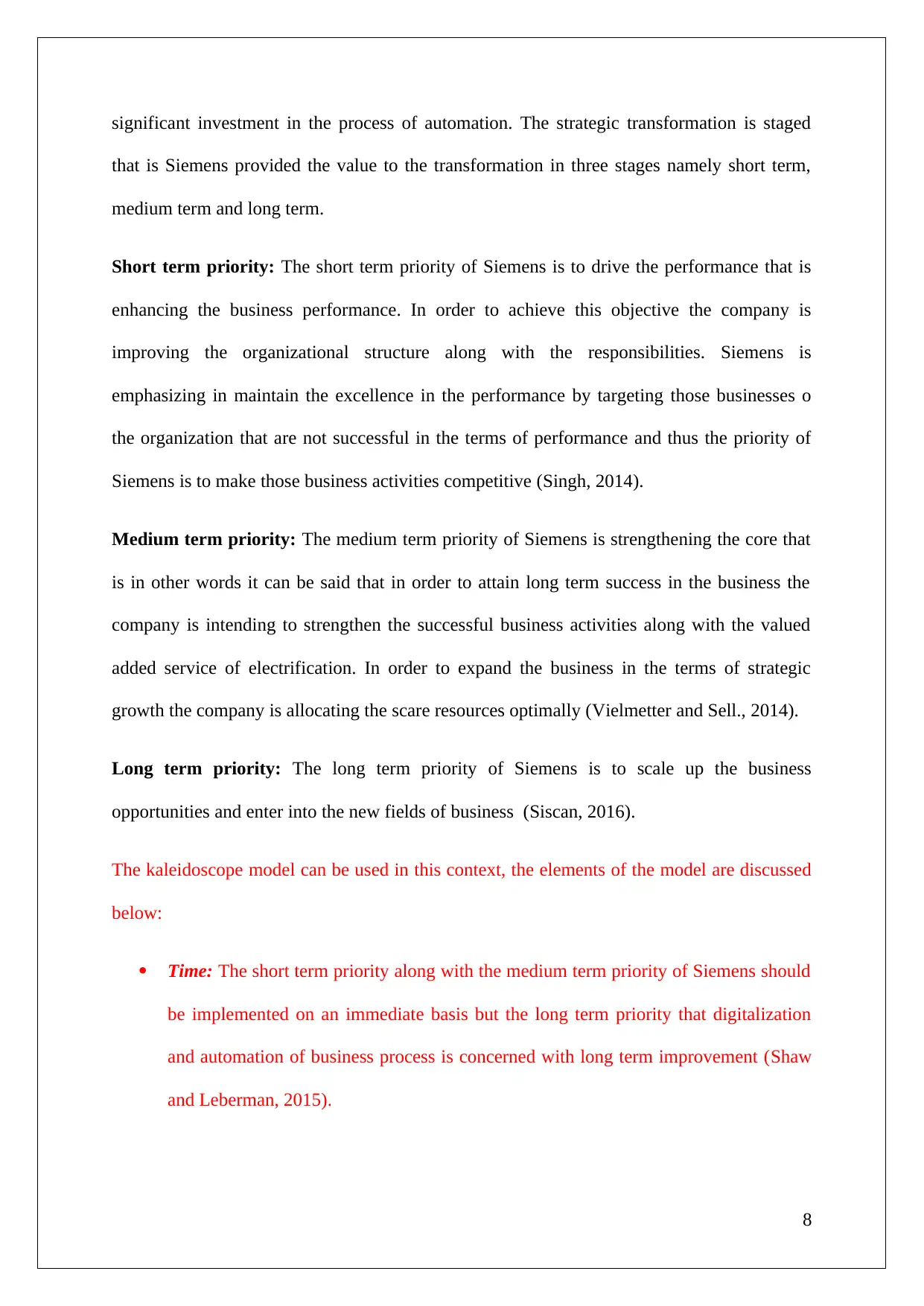
significant investment in the process of automation. The strategic transformation is staged
that is Siemens provided the value to the transformation in three stages namely short term,
medium term and long term.
Short term priority: The short term priority of Siemens is to drive the performance that is
enhancing the business performance. In order to achieve this objective the company is
improving the organizational structure along with the responsibilities. Siemens is
emphasizing in maintain the excellence in the performance by targeting those businesses o
the organization that are not successful in the terms of performance and thus the priority of
Siemens is to make those business activities competitive (Singh, 2014).
Medium term priority: The medium term priority of Siemens is strengthening the core that
is in other words it can be said that in order to attain long term success in the business the
company is intending to strengthen the successful business activities along with the valued
added service of electrification. In order to expand the business in the terms of strategic
growth the company is allocating the scare resources optimally (Vielmetter and Sell., 2014).
Long term priority: The long term priority of Siemens is to scale up the business
opportunities and enter into the new fields of business (Siscan, 2016).
The kaleidoscope model can be used in this context, the elements of the model are discussed
below:
Time: The short term priority along with the medium term priority of Siemens should
be implemented on an immediate basis but the long term priority that digitalization
and automation of business process is concerned with long term improvement (Shaw
and Leberman, 2015).
8
that is Siemens provided the value to the transformation in three stages namely short term,
medium term and long term.
Short term priority: The short term priority of Siemens is to drive the performance that is
enhancing the business performance. In order to achieve this objective the company is
improving the organizational structure along with the responsibilities. Siemens is
emphasizing in maintain the excellence in the performance by targeting those businesses o
the organization that are not successful in the terms of performance and thus the priority of
Siemens is to make those business activities competitive (Singh, 2014).
Medium term priority: The medium term priority of Siemens is strengthening the core that
is in other words it can be said that in order to attain long term success in the business the
company is intending to strengthen the successful business activities along with the valued
added service of electrification. In order to expand the business in the terms of strategic
growth the company is allocating the scare resources optimally (Vielmetter and Sell., 2014).
Long term priority: The long term priority of Siemens is to scale up the business
opportunities and enter into the new fields of business (Siscan, 2016).
The kaleidoscope model can be used in this context, the elements of the model are discussed
below:
Time: The short term priority along with the medium term priority of Siemens should
be implemented on an immediate basis but the long term priority that digitalization
and automation of business process is concerned with long term improvement (Shaw
and Leberman, 2015).
8
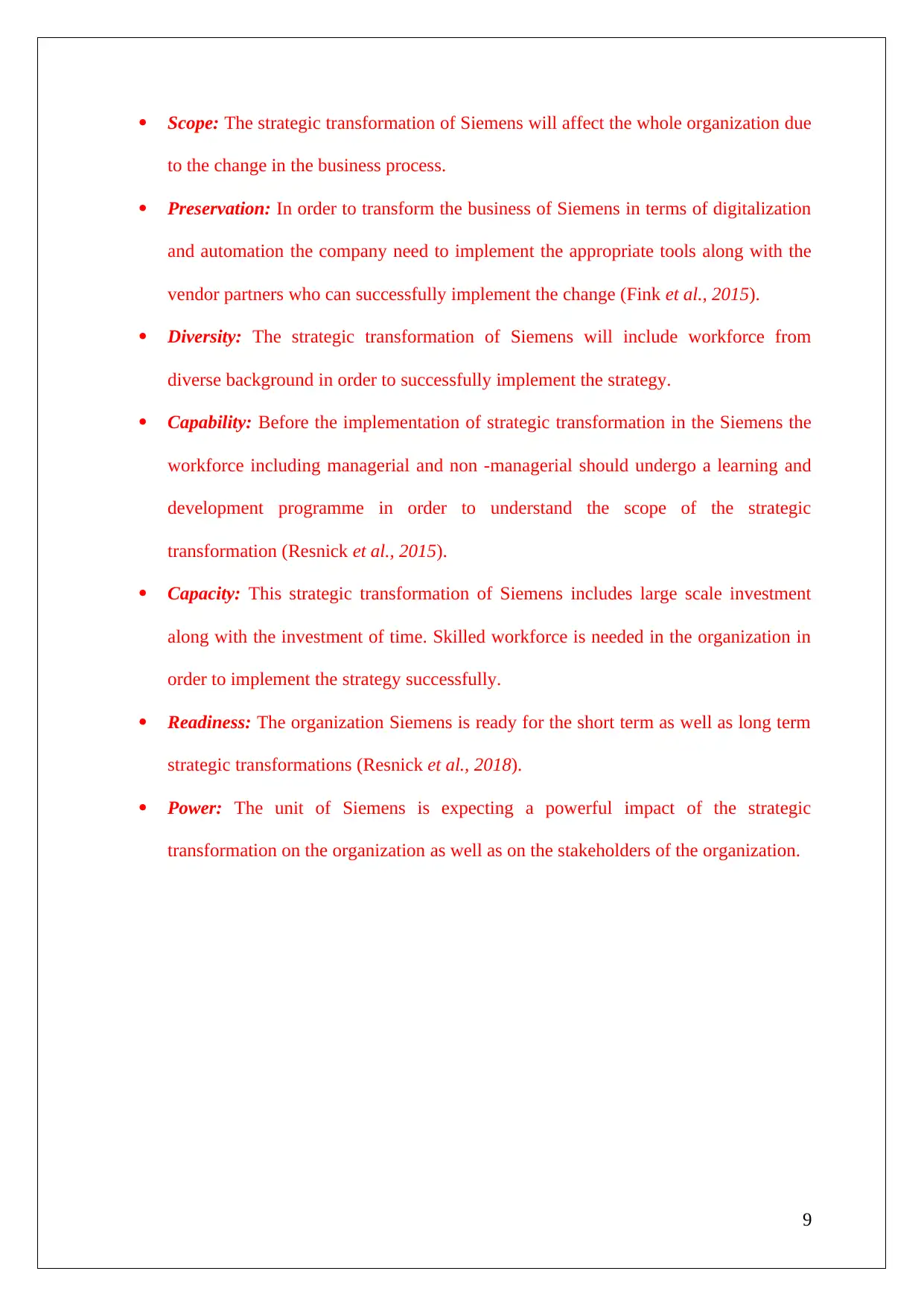
Scope: The strategic transformation of Siemens will affect the whole organization due
to the change in the business process.
Preservation: In order to transform the business of Siemens in terms of digitalization
and automation the company need to implement the appropriate tools along with the
vendor partners who can successfully implement the change (Fink et al., 2015).
Diversity: The strategic transformation of Siemens will include workforce from
diverse background in order to successfully implement the strategy.
Capability: Before the implementation of strategic transformation in the Siemens the
workforce including managerial and non -managerial should undergo a learning and
development programme in order to understand the scope of the strategic
transformation (Resnick et al., 2015).
Capacity: This strategic transformation of Siemens includes large scale investment
along with the investment of time. Skilled workforce is needed in the organization in
order to implement the strategy successfully.
Readiness: The organization Siemens is ready for the short term as well as long term
strategic transformations (Resnick et al., 2018).
Power: The unit of Siemens is expecting a powerful impact of the strategic
transformation on the organization as well as on the stakeholders of the organization.
9
to the change in the business process.
Preservation: In order to transform the business of Siemens in terms of digitalization
and automation the company need to implement the appropriate tools along with the
vendor partners who can successfully implement the change (Fink et al., 2015).
Diversity: The strategic transformation of Siemens will include workforce from
diverse background in order to successfully implement the strategy.
Capability: Before the implementation of strategic transformation in the Siemens the
workforce including managerial and non -managerial should undergo a learning and
development programme in order to understand the scope of the strategic
transformation (Resnick et al., 2015).
Capacity: This strategic transformation of Siemens includes large scale investment
along with the investment of time. Skilled workforce is needed in the organization in
order to implement the strategy successfully.
Readiness: The organization Siemens is ready for the short term as well as long term
strategic transformations (Resnick et al., 2018).
Power: The unit of Siemens is expecting a powerful impact of the strategic
transformation on the organization as well as on the stakeholders of the organization.
9
⊘ This is a preview!⊘
Do you want full access?
Subscribe today to unlock all pages.

Trusted by 1+ million students worldwide
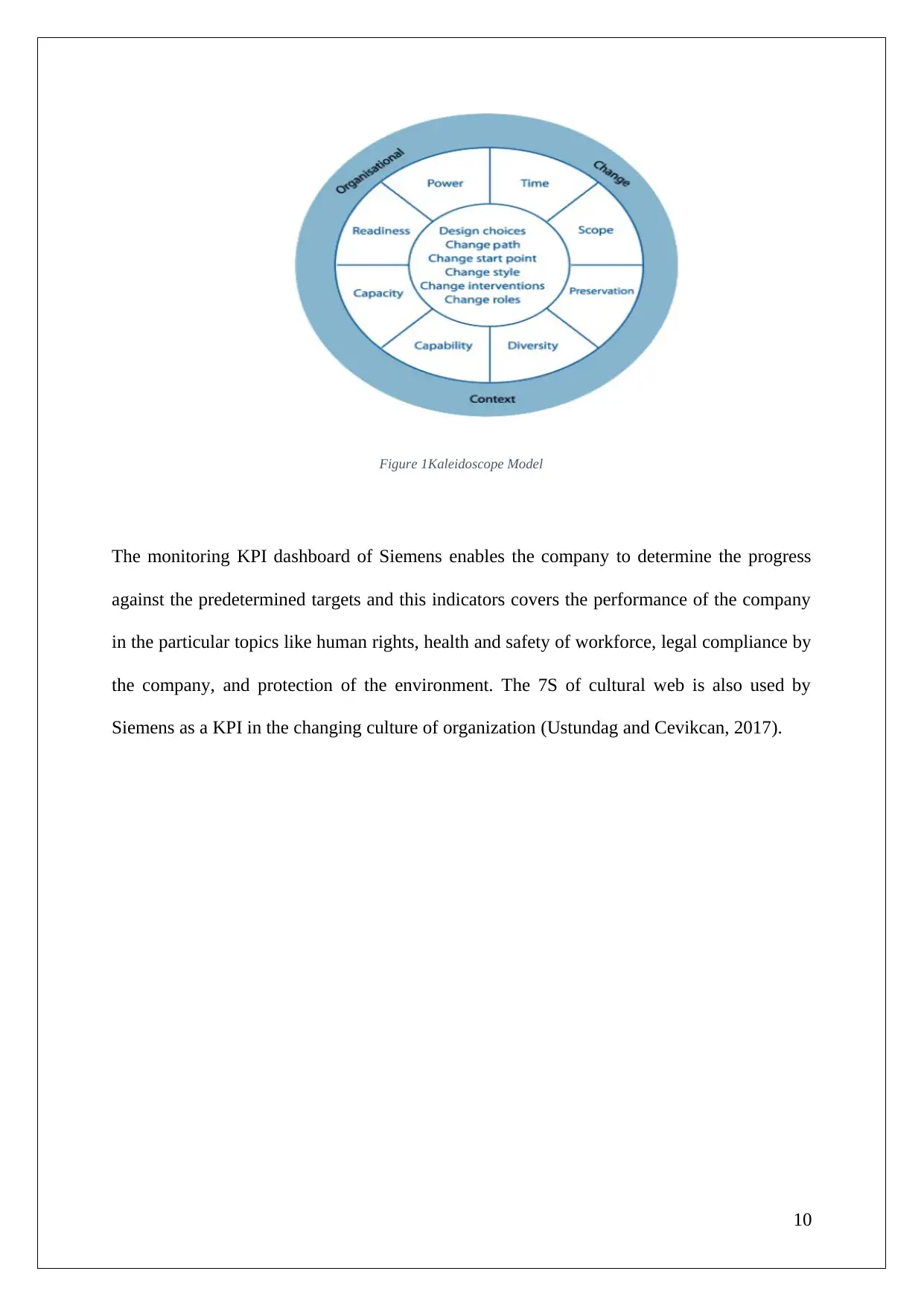
Figure 1Kaleidoscope Model
The monitoring KPI dashboard of Siemens enables the company to determine the progress
against the predetermined targets and this indicators covers the performance of the company
in the particular topics like human rights, health and safety of workforce, legal compliance by
the company, and protection of the environment. The 7S of cultural web is also used by
Siemens as a KPI in the changing culture of organization (Ustundag and Cevikcan, 2017).
10
The monitoring KPI dashboard of Siemens enables the company to determine the progress
against the predetermined targets and this indicators covers the performance of the company
in the particular topics like human rights, health and safety of workforce, legal compliance by
the company, and protection of the environment. The 7S of cultural web is also used by
Siemens as a KPI in the changing culture of organization (Ustundag and Cevikcan, 2017).
10
Paraphrase This Document
Need a fresh take? Get an instant paraphrase of this document with our AI Paraphraser
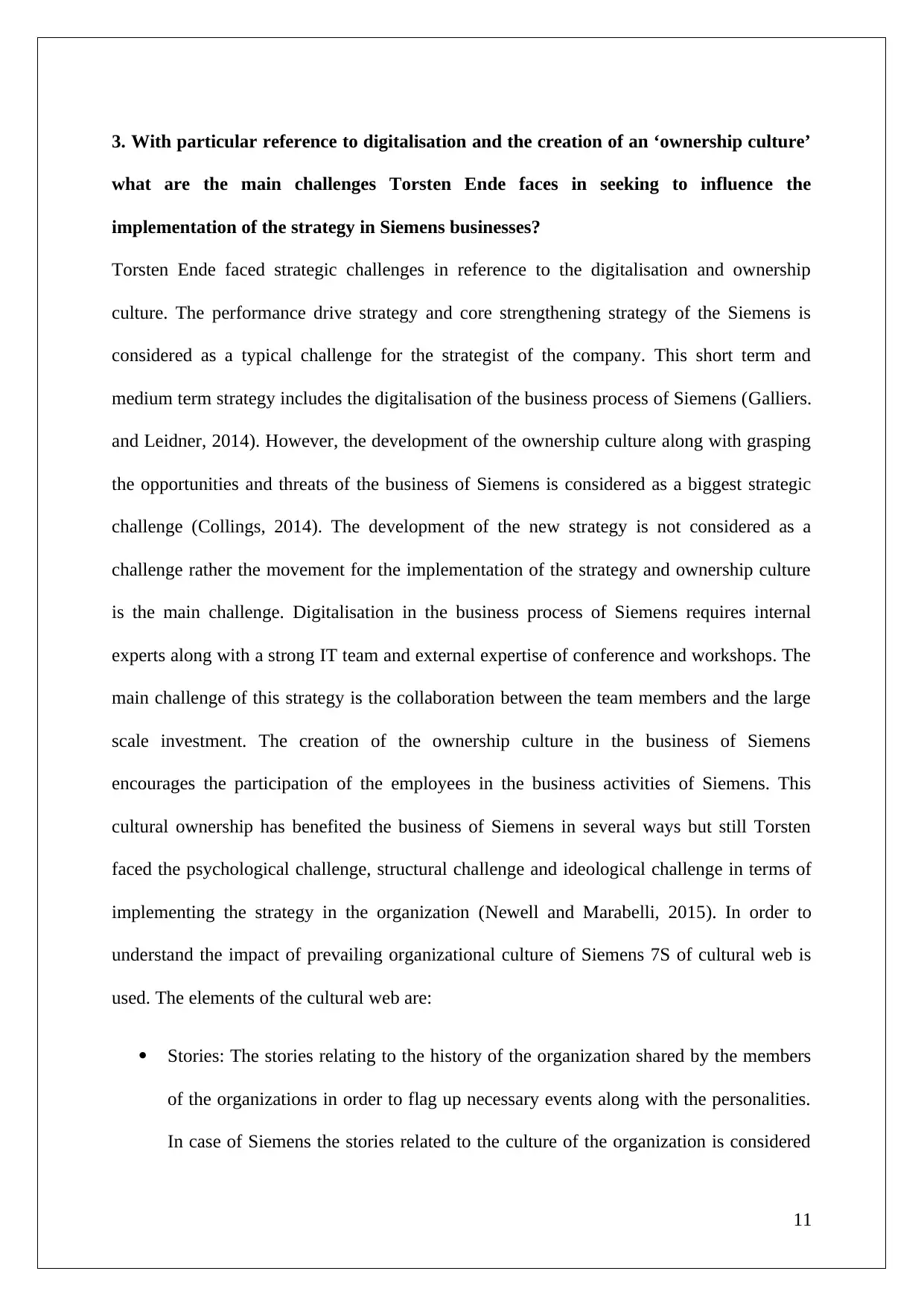
3. With particular reference to digitalisation and the creation of an ‘ownership culture’
what are the main challenges Torsten Ende faces in seeking to influence the
implementation of the strategy in Siemens businesses?
Torsten Ende faced strategic challenges in reference to the digitalisation and ownership
culture. The performance drive strategy and core strengthening strategy of the Siemens is
considered as a typical challenge for the strategist of the company. This short term and
medium term strategy includes the digitalisation of the business process of Siemens (Galliers.
and Leidner, 2014). However, the development of the ownership culture along with grasping
the opportunities and threats of the business of Siemens is considered as a biggest strategic
challenge (Collings, 2014). The development of the new strategy is not considered as a
challenge rather the movement for the implementation of the strategy and ownership culture
is the main challenge. Digitalisation in the business process of Siemens requires internal
experts along with a strong IT team and external expertise of conference and workshops. The
main challenge of this strategy is the collaboration between the team members and the large
scale investment. The creation of the ownership culture in the business of Siemens
encourages the participation of the employees in the business activities of Siemens. This
cultural ownership has benefited the business of Siemens in several ways but still Torsten
faced the psychological challenge, structural challenge and ideological challenge in terms of
implementing the strategy in the organization (Newell and Marabelli, 2015). In order to
understand the impact of prevailing organizational culture of Siemens 7S of cultural web is
used. The elements of the cultural web are:
Stories: The stories relating to the history of the organization shared by the members
of the organizations in order to flag up necessary events along with the personalities.
In case of Siemens the stories related to the culture of the organization is considered
11
what are the main challenges Torsten Ende faces in seeking to influence the
implementation of the strategy in Siemens businesses?
Torsten Ende faced strategic challenges in reference to the digitalisation and ownership
culture. The performance drive strategy and core strengthening strategy of the Siemens is
considered as a typical challenge for the strategist of the company. This short term and
medium term strategy includes the digitalisation of the business process of Siemens (Galliers.
and Leidner, 2014). However, the development of the ownership culture along with grasping
the opportunities and threats of the business of Siemens is considered as a biggest strategic
challenge (Collings, 2014). The development of the new strategy is not considered as a
challenge rather the movement for the implementation of the strategy and ownership culture
is the main challenge. Digitalisation in the business process of Siemens requires internal
experts along with a strong IT team and external expertise of conference and workshops. The
main challenge of this strategy is the collaboration between the team members and the large
scale investment. The creation of the ownership culture in the business of Siemens
encourages the participation of the employees in the business activities of Siemens. This
cultural ownership has benefited the business of Siemens in several ways but still Torsten
faced the psychological challenge, structural challenge and ideological challenge in terms of
implementing the strategy in the organization (Newell and Marabelli, 2015). In order to
understand the impact of prevailing organizational culture of Siemens 7S of cultural web is
used. The elements of the cultural web are:
Stories: The stories relating to the history of the organization shared by the members
of the organizations in order to flag up necessary events along with the personalities.
In case of Siemens the stories related to the culture of the organization is considered
11
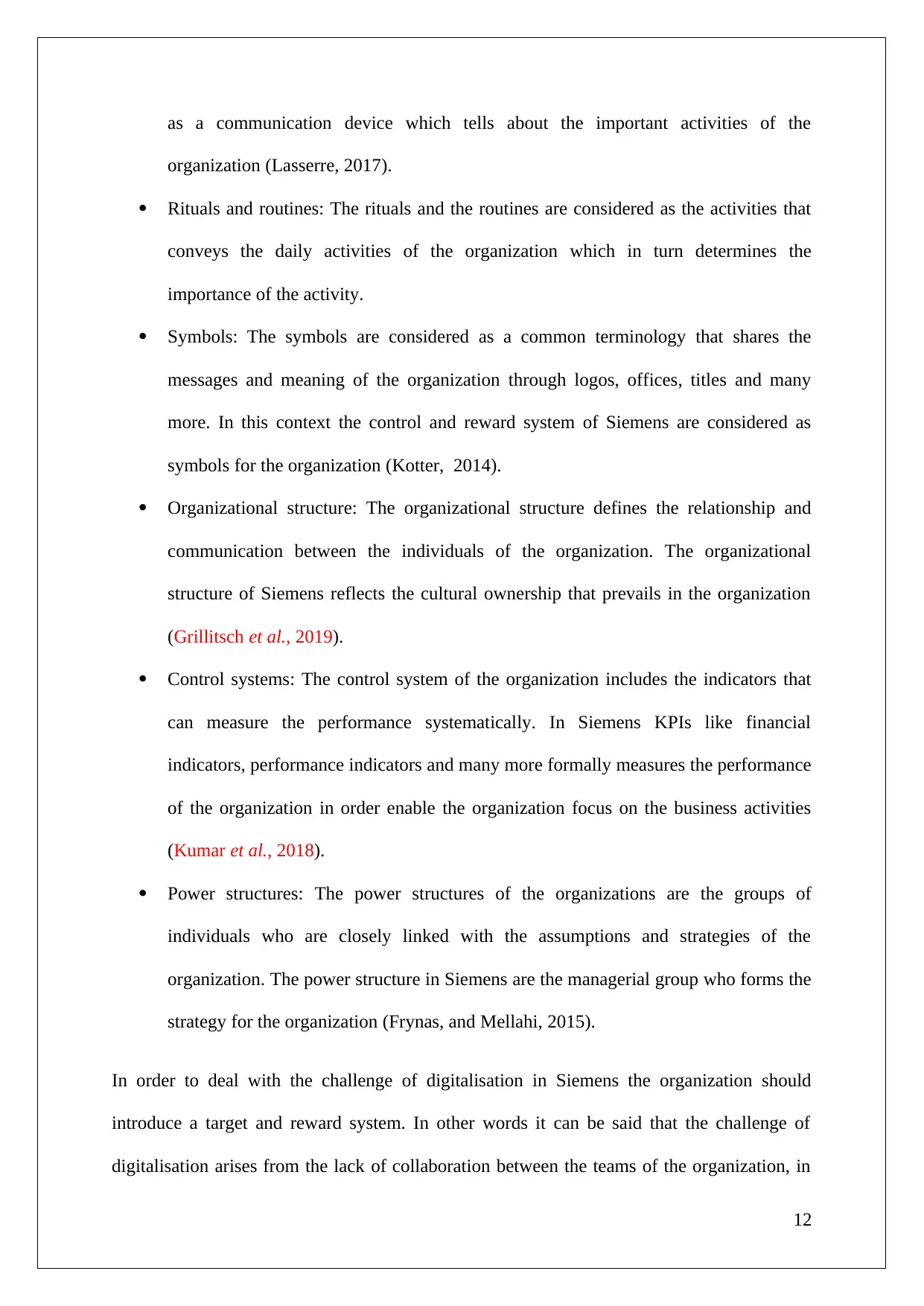
as a communication device which tells about the important activities of the
organization (Lasserre, 2017).
Rituals and routines: The rituals and the routines are considered as the activities that
conveys the daily activities of the organization which in turn determines the
importance of the activity.
Symbols: The symbols are considered as a common terminology that shares the
messages and meaning of the organization through logos, offices, titles and many
more. In this context the control and reward system of Siemens are considered as
symbols for the organization (Kotter, 2014).
Organizational structure: The organizational structure defines the relationship and
communication between the individuals of the organization. The organizational
structure of Siemens reflects the cultural ownership that prevails in the organization
(Grillitsch et al., 2019).
Control systems: The control system of the organization includes the indicators that
can measure the performance systematically. In Siemens KPIs like financial
indicators, performance indicators and many more formally measures the performance
of the organization in order enable the organization focus on the business activities
(Kumar et al., 2018).
Power structures: The power structures of the organizations are the groups of
individuals who are closely linked with the assumptions and strategies of the
organization. The power structure in Siemens are the managerial group who forms the
strategy for the organization (Frynas, and Mellahi, 2015).
In order to deal with the challenge of digitalisation in Siemens the organization should
introduce a target and reward system. In other words it can be said that the challenge of
digitalisation arises from the lack of collaboration between the teams of the organization, in
12
organization (Lasserre, 2017).
Rituals and routines: The rituals and the routines are considered as the activities that
conveys the daily activities of the organization which in turn determines the
importance of the activity.
Symbols: The symbols are considered as a common terminology that shares the
messages and meaning of the organization through logos, offices, titles and many
more. In this context the control and reward system of Siemens are considered as
symbols for the organization (Kotter, 2014).
Organizational structure: The organizational structure defines the relationship and
communication between the individuals of the organization. The organizational
structure of Siemens reflects the cultural ownership that prevails in the organization
(Grillitsch et al., 2019).
Control systems: The control system of the organization includes the indicators that
can measure the performance systematically. In Siemens KPIs like financial
indicators, performance indicators and many more formally measures the performance
of the organization in order enable the organization focus on the business activities
(Kumar et al., 2018).
Power structures: The power structures of the organizations are the groups of
individuals who are closely linked with the assumptions and strategies of the
organization. The power structure in Siemens are the managerial group who forms the
strategy for the organization (Frynas, and Mellahi, 2015).
In order to deal with the challenge of digitalisation in Siemens the organization should
introduce a target and reward system. In other words it can be said that the challenge of
digitalisation arises from the lack of collaboration between the teams of the organization, in
12
⊘ This is a preview!⊘
Do you want full access?
Subscribe today to unlock all pages.

Trusted by 1+ million students worldwide
1 out of 21
Related Documents
Your All-in-One AI-Powered Toolkit for Academic Success.
+13062052269
info@desklib.com
Available 24*7 on WhatsApp / Email
![[object Object]](/_next/static/media/star-bottom.7253800d.svg)
Unlock your academic potential
Copyright © 2020–2025 A2Z Services. All Rights Reserved. Developed and managed by ZUCOL.





